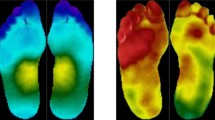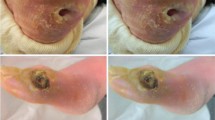Abstract
In today’s scenario, Diabetes Mellitus (DM) is a major medical issue that comes with numerous complications. It is the most imperative disease associated with a diabetic foot. Among other conditions, one of the most common symptoms of diabetes is a diabetic foot ulcer. The early diagnosis of such foot perplexities, which may later lead to foot removal, can shield diabetic patients from many critical stages. The main objective of this work relies on the area of early diagnosis and minimizing the occurrence of ulcers in the diabetic foot. Infrared imaging is an appropriate tool that extracts information for the determination of various diseases. The primary purpose of applying infrared imaging in a diabetic patient is for the early diagnosis of ulcers. This type of diagnosis is non-invasive and faster than colored imaging techniques. This work focuses on temperature variation in the feet of more than 60 persons (37 men (61.67%) and 23 women (38.33%)). The mean age of persons for detecting ulcer formation due to diabetes is 60.50 ± 16.71 years. The foot is divided into six major segments, followed by close observation of the individual part’s temperature variation. In the proposed work, image registration is applied to measure the temperature difference between the regions of feet, assuming the threshold temperature as 2.2 °C. The results are obtained using the image processing toolbox of MATLAB. After experimental operations, the results clearly distinguish the foot region, having a temperature difference higher than the assumed threshold value. This analysis distinctly classifies the ulcer risk foot and is quite easy to understand as compared with existing Deep Learning techniques. The proposed methodology is also very less complex in implementation as compared to those of Deep Learning methods. It provides a non-invasive technique for the diagnosis of foot ulcers in a diabetic patient using infrared imaging.,








Similar content being viewed by others
References
Prabhu SM and Verma S (2019) Comparative analysis of segmentation techniques for progressive evaluation and risk identification of diabetic foot ulcers,” In: Proceedings IEEE 4th M.E.C. International Conference On Big Data And Smart City (ICBDSC), 1–6. https://doi.org/10.1109/ICBDSC.2019.8645591
Vilcahuaman L (2013) Early diagnosis of diabetic foot using thermal images. 2013, 139.
Singh N et al (2005) Preventing foot ulcers in patients with diabetes. J Am Med Assoc 293(2):217–228. https://doi.org/10.1001/jama.293.2.217
Astasio-Picado A et al (2018) Thermal map of the diabetic foot using infrared thermography. Infrared Phys Technol 93:59–62. https://doi.org/10.1016/j.infrared.2018.07.008
Ilo A et al (2019) Infrared thermography and vascular disorders in diabetic feet. J Diabetes Sci Technol 14(1):28–36. https://doi.org/10.1177/1932296819871270
Bayareh R et al (2018) Thermographic study of the diabetic foot of patients with diabetes mellitus and healthy patients, Global Medical Engineering Physics Exchanges/Pan American Health Care Exchanges (GMEPE/PAHCE), Porto, https://doi.org/10.1109/GMEPE-PAHCE.2018.8400742.
Armstrong DG et al (2007) Skin temperature monitoring reduces the risk for diabetic foot ulceration in high-risk patients. Am J Med 120(12):1042–1046. https://doi.org/10.1016/j.amjmed.2007.06.028
Liu C et al (2013) Infrared dermal thermography on diabetic feet soles to predict ulcerations: a case study, Progress in Biomedical Optics and Imaging- PROC SPIE., 2013, 85720N. https://doi.org/10.1117/12.2001807.
Holzinger A et al (2019) Causability and explainability of artificial intelligence in medicine. Wiley Interdiscip Rev: Data Mining Knowl Discov. https://doi.org/10.1002/widm.1312
Husain AA et al (2020) Vehicle detection in intelligent transport system under a hazy environment: a survey. IET Image Process 14:1–10. https://doi.org/10.1049/iet-ipr.2018.5351
Sun PC et al (2005) Assessing foot temperature using infrared thermography. Foot Ankle Int 26(10):847–853. https://doi.org/10.1177/107110070502601010
Hendee WR, Ritenour ER (2002) Medical imaging physics, 4th edn. John Wiley & Sons, New York
Jones BF, Plassmann P (2002) Imaging of human skin. IEEE Eng Med Biol Mag 21:41–48. https://doi.org/10.1109/MEMB.2002.1175137
Jeffcoate WJ et al (2018) Current challenges and opportunities in the prevention and management of diabetic foot ulcers. Diabetes Care 41(2018):645–652. https://doi.org/10.2337/dc17-1836
Sharma S et al (2014) A brief review on leading big data models. Data Sci J 13:138–157. https://doi.org/10.2481/dsj.14-041
Petrova NL et al (2018) Reliability of a novel thermal imaging system for temperature assessment of healthy feet. J Foot Ankle Res. https://doi.org/10.1186/s13047-018-0266-1
Sherman RA et al (1996) Comparative effectiveness of video thermography, contact thermography, and infrared beam thermography for scanning relative skin temperature. J Rehabil Res Dev 33:377–386
Armstrong DG, Lavery LA (1997) Monitoring healing of acute Charcot’s arthropathy with infrared dermal thermometry. J Rehabil Res Dev 34(3):317–321
Sun PC et al (2006) Relationship of skin temperature to sympathetic dysfunction in diabetic at-risk feet. Diabetes Res Clin Pract 73(1):41–46. https://doi.org/10.1016/j.diabres.2005.12.012
Balbinot LF et al (2012) Plantar thermography is useful in the early diagnosis of diabetic neuropathy. Clinics (Sao Paulo, Brazil), 67(12), 1419–25. https://doi.org/10.6061/clinics/2012(12)12
Bergtholdt HT and MS (1979) Temperature assessment of the insensitive foot. Phys Ther, 59(1), 18–22, https://doi.org/10.1093/ptj/59.1.18
Rubinstein EH, Sessler DI (1990) Skin-surface temperature gradients correlate with fingertip blood flow in humans. Anesthesiology 73(3):541–545
Gururajarao SB et al (2018) Infrared thermography and soft computing for diabetic foot assessment. Mach Learn Bio-Signal Anal Diagn Imaging. https://doi.org/10.1016/B978-0-12-816086-2.00004-7
Van Doremalen RFM et al (2020) Infrared 3D thermography for inflammation detection in diabetic foot disease: a proof of concept. J Diabetes Sci Technol 14(1):46–54. https://doi.org/10.1177/1932296819854062
Fraiwan L et al (2017) Diabetic foot ulcer mobile detection system using smartphone thermal camera: a feasibility study. Biomed Eng 16:1–19. https://doi.org/10.1186/s12938-017-0408-x
Liu C et al (2015) Automatic detection of diabetic foot complications with infrared thermography by asymmetric analysis. J Biomed Opt 20(2):26003. https://doi.org/10.1117/1.JBO.20.2.026003
Carbonell L et al (2018) Thermographic quantitative variables for diabetic foot assessment: preliminary results. Comput Methods Biomech Biomed Eng: Imaging Vis. https://doi.org/10.1080/21681163.2018.1542349
Netten V, Jaap J et al (2013) Infrared thermal imaging for automated detection of diabetic foot complications. J Diabetes Sci Technol 7(5):1122–1129. https://doi.org/10.1177/193229681300700504
Gatt A et al (2018) Establishing differences in thermographic patterns between the various complications in diabetic foot disease, Int J Endocrinol. Hindawi, 1–7. https://doi.org/10.1155/2018/9808295
Sethi H et al (2017) Artificial Intelligence based ensemble model for diagnosis of diabetes”. Int J Adv Res Com Sci 8:1540. https://doi.org/10.2648/ijarcs.v8i5.3805
Vega C et al (2020) Deep learning classification for diabetic foot thermograms. Sensors 20(6):1762. https://doi.org/10.3390/s20061762
Maldonado H et al (2020) Automatic detection of risk zones in diabetic foot soles by processing thermographic images taken in an uncontrolled environment. Infrared Phys Technol 105:103187. https://doi.org/10.1016/j.infrared.2020.103187
Kavakiotis I et al (2017) Machine learning and data mining methods in diabetes research. Comput Struct Biotechnol J 15:104–116. https://doi.org/10.1016/j.csbj.2016.12.005
Goyal M et al (2018) Dfunet: convolutional neural networks for diabetic foot ulcer classification. IEEE Transactions on Emerging Topics in Computational Intelligence, 2018. https://doi.org/10.1109/TETCI.2018.2866254
Wang Y et al (2021) An update on potential biomarkers for diagnosing diabetic foot ulcer at early stage. Biomed Pharmacother 133:110991
Khandakar A (2021) A machine learning model for early detection of diabetic foot using thermogram images, arXiv e-prints.
Tulloch J et al (2020) Machine learning in the prevention, diagnosis and management of diabetic foot ulcers: a systematic review. IEEE Access 8:198977–199000. https://doi.org/10.1109/ACCESS.2020.3035327
Thomas NJ et al (2019) Type 1 diabetes defined by severe insulin deficiency occurs after 30 years of age and is commonly treated as type 2 diabetes. Diabetologia 62:1167–1172. https://doi.org/10.1007/s00125-019-4863-8
Sharp SA et al (2019) Development and standardization of an improved type 1 diabetes genetic risk score for use in newborn screening and incident diagnosis. Diabetes Care 42:200–207. https://doi.org/10.2337/dc18-1785
Abraham A et al (2017) Intelligent systems design and applications, 17th International Conference on Intelligent Systems Design and Applications. https://doi.org/10.1007/978-3-540-44999-7
Bhattacharjee S et al (2017) Automated detection of diabetic retinopathy using weighted support vector machines, Intelligent Systems Design And Applications 17th International Conference On Intelligent Systems Design And Applications, 2017. https://doi.org/10.1007/978-3-319-76348-4_35
Pai MMM et al (2019) Development of smart sole based foot ulcer prediction system, In: 2nd International Conference On Intelligent Communication And Computational Techniques (ICCT), Jaipur, India, 87–90. https://doi.org/10.1109/ICCT46177.2019.8968777
Hernandez-Contreras AD et al (2019) Plantar thermogram database for the study of diabetic foot complications. IEEE Access 7:161296–161307. https://doi.org/10.21227/tm4t-9n15
Rai M et al (2018) Thermal imaging system and its real time applications: a survey. Article J Eng Technol 6(2):290–303
Prabhu SM, and Verma S (2019) A Systematic Literature Review for Early Detection of Type, II Diabetes, In: Proceedings IEEE International Conference On Advanced Computing & Communication Systems (ICACCS), 2019, 1–5. https://doi.org/10.1109/ICACCS.2019.8728377
Harding JR et al (1998) Infrared imaging in diabetic foot ulceration, In: Engineering in Medicine And Biology Society Proceedings of the 20th Annual International Conference of the IEEE, 2, 916–918. https://doi.org/10.1109/IEMBS.1998.745591
Ugwu E et al (2019) Predictors of lower extremity amputation in patients with diabetic foot ulcer: findings from MEDFUN, a multi-center observational study. J Foot Ankle Res. https://doi.org/10.1186/s13047-019-0345-y
Ammer K et al (2001) Thermal imaging of skin changes on the feet of Type II diabetics, Proc IEEE Int Conf Eng Med Biol Soc, 2001, 2870–2872. https://doi.org/10.1109/IEMBS.2001.1017387
Lahiri BB et al (2012) Medical applications of infrared thermography: a review. Infrared Phys Technol 55(4):221–235. https://doi.org/10.1016/j.infrared.2012.03.007
Hernandez-Contreras D et al (2016) Narrative review: diabetic foot and infrared thermography. Infrared Phys Techno 78:105–117. https://doi.org/10.1016/j.infrared.2016.07.013
Salazar CA, Zequera Díaz ML (2020), Thermography as a diagnostic tool for early detection of diabetic foot ulceration risk: a review, IFMBE Proceedings. 75. Springer, 2020. 1233–1252. https://doi.org/10.1007/978-3-030-30648-9_161
Author information
Authors and Affiliations
Corresponding author
Ethics declarations
Conflict of interest
The permission has been taken from the persons for utilizing their foot images for all the above research work. He is one of the coauthors of this paper.
Additional information
Publisher's Note
Springer Nature remains neutral with regard to jurisdictional claims in published maps and institutional affiliations.
Rights and permissions
About this article
Cite this article
Rai, M., Maity, T., Sharma, R. et al. Early detection of foot ulceration in type II diabetic patient using registration method in infrared images and descriptive comparison with deep learning methods. J Supercomput 78, 13409–13426 (2022). https://doi.org/10.1007/s11227-022-04380-z
Accepted:
Published:
Issue Date:
DOI: https://doi.org/10.1007/s11227-022-04380-z




